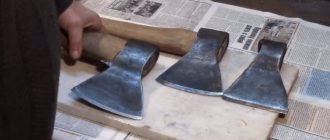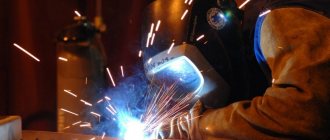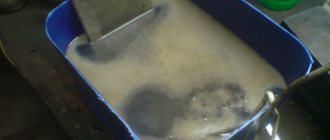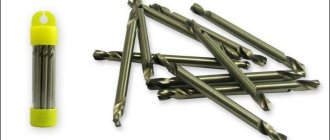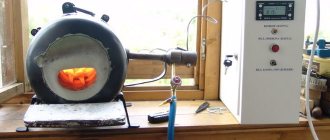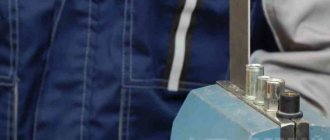Despite the fact that such a technological procedure as hardening stainless steel products leads to a decrease in their ductility and flexibility, the use of this heat treatment method makes it possible to give them exceptional hardness. Modern hardening technologies and their correct selection provide high quality steel, in which the proportions of strength, ductility and toughness are optimally maintained. Products treated in this way have significantly improved performance characteristics.
Hardening of steel in an induction channel installation
Annealing, hardening and heat treatment of stainless steel
You are interested in heat treatment, annealing, hardening of stainless steel. The supplier Avec Global offers to buy stainless steel of domestic and foreign production at an affordable price in a wide range. We will ensure delivery of products to any point on the continent. The price is optimal.
Relevance
Stainless steel is usually heat treated to relieve stress, strengthen it, or increase ductility. Heat treatment is carried out under controlled conditions to avoid carburization and decarburization.
Annealing
Annealing is used to recrystallize the structure of austenitic stainless steels and stimulate the formation of chromium carbides. In addition, this treatment eliminates stresses generated during previous processing and homogenizes welds. Temperatures for short-term annealing of stainless steels are above 1040 °C to prevent grain growth in the structure. The controlled annealing temperature of some alloys may be lower based on grain size.
Why is heat treatment of metal necessary?
The operation is carried out to improve the technological qualities of raw materials. The key factor is the annealing temperature of the steel, which must be maintained for a certain time. In this case, the following goals are achieved:
- Reduced hardness. Quality indicators after processing can significantly reduce labor costs and reduce operation time using a wider range of cutting tools.
- Improvement of microstructure. Under the influence of high temperature, significant changes occur at the molecular level over a certain period of time. The resulting homogeneous steel structure after annealing is optimal for subsequent mechanical and physical operations.
- To relieve internal stress. During primary processing at metallurgical enterprises, an imbalance in the crystalline structure occurs in the metal. By correctly selecting the types of steel annealing, the required characteristics of the metal for a particular case are achieved.
Sometimes incomplete annealing of steel is sufficient to obtain the required technological conditions. Depending on the desired quality characteristics of the metal, complex and time-consuming modes can be used. Complete annealing of steel can take more than a day for large products. Most of this time is occupied by heating to the desired temperature and slow cooling, regulated by the type of heat treatment at a given standard.
The steel annealing mode is described in detail in specialized literature. Some operations require adherence to a time regime and precise temperature, down to several degrees. If you have a muffle furnace, then the procedure can be performed efficiently. When such equipment is not available, it will be difficult to accurately carry out certain types of heat treatment. You will have to navigate solely by the color of the hot metal.
You can anneal steel at home using a simplified procedure. It is definitely not possible to control the temperature of an object heated by a gas burner. It is possible to regulate the heating and cooling modes of the metal only approximately. When processing steel at home, it is impossible to do a structural analysis. The temperature of incomplete annealing is determined only visually. The goals in domestic conditions are to reduce the strength and increase the workability of the product. The microstructure of steel changes after annealing and further operations can be carried out.
How to harden metal at home
Using basic knowledge, you can harden steel at home. Heating of metal is usually carried out using a fire, electric muffle furnaces or gas burners.
Hardening an ax at the stake and in the oven
If you need to give additional strength to household tools, for example, to make an ax more durable, then the easiest way to harden it can be done at home.
During manufacture, axes are stamped with a mark by which you can identify the grade of steel. We will look at the hardening process using U7 tool steel as an example.
The technology must be performed in compliance with the following rules:
1. Annealing . Before processing, dull the sharp edge of the blade and place the ax in a burning brick oven to heat. The heat treatment procedure must be carefully monitored to prevent overheating (permissible heating is 720-780°C). More advanced craftsmen recognize the temperature by the color of the heat.
And beginners can find out the temperature using a magnet. If the magnet stops sticking to the metal, it means the ax has heated up above 768°C (red-burgundy color) and it’s time to cool down.
Use a poker to move the hot ax to the oven door, remove the heat deeper, close the door and valve, leave the heated metal in the oven for 10 hours. Let the ax gradually cool down with the stove.
2. Hardening of steel . Heat the ax over a fire, potbelly stove or stove until dark red - temperature 800-830°C (the magnet has stopped magnetizing, wait another 2-3 minutes).
Quenching is performed in heated water (30°C) and oil. Lower the ax blade into the water 3-4 cm, moving it vigorously.
Next, place the ax in a container with oil; if the oil catches fire, cover the container with a thick cloth. Keep in oil until completely cool.
3. Release of the ax blade . Tempering reduces the brittleness of steel and relieves internal stress. Sand the metal with sandpaper to better distinguish the colors of the paint.
Place the ax in the oven for 1 hour at a temperature of 270-320°C. After standing, remove and cool in air.
Video: heat treatment of an ax at home, three stages: annealing, hardening, tempering.
Classification of stainless steel and alloys
The classification of alloys that belong to stainless materials is presented in GOST 5632-72. This standard provides for the division of stainless steels into three types:
- Corrosion-resistant materials – resistant to chemical and electrochemical corrosion (salt, atmospheric, acid, alkaline), as well as corrosion that spreads along crystal grains.
- Heat-resistant (scale-resistant) – stainless alloys that are resistant to corrosion and chemical attack at temperatures above +550 °C in gaseous environments.
- Heat-resistant - steels that retain their properties when loaded, under high temperature conditions for a certain period of time.
GOST 5632-72 presents a classification of stainless steels depending on their structure:
- Martensitic steels, which have martensite as their main structural component. They contain from 12 to 17% Cr (chromium steels) and have a sufficiently high carbon (C) content that such alloys can be hardened.
- Martensitic-ferritic alloys have a structure that, in addition to martensite, contains more than 10% ferrite. They include 13 to 18% Cr (chromium steels).
- Ferritic steels are characterized by a structure based on ferrite. They contain from 13 to 30% Cr (chromium steel). Such alloys are characterized by magnetic properties. They have an affordable cost, due to their low nickel content.
- Austenitic-martensitic steels have a structure consisting of austenite and martensite in certain proportions. They include from 12 to 18% Cr and from 4 to 9% Ni (chromium-nickel and chromium-manganese-nickel steels).
- Austenitic-ferritic alloys have a structure that includes austenite and at least 10% ferrite (chromium-nickel and chromium-manganese-nickel steels).
- Austenitic steels have a structure based on austenite (chromium-nickel steels, chromium-manganese-nickel steels).
The structures described above are obtained by cooling the alloys after heat treatment of stainless steel has been carried out. The formation of the structure of the material is significantly influenced by the chemical composition. Particularly important elements are chromium and nickel. Changes in the structure of alloys occur under the influence of hot or cold working.
Differences in hardening between stainless steel and carbon steel
All alloying elements included in the composition of corrosion-resistant steel are conventionally divided into two groups:
- The first is elements that increase the temperature of the polymorphic transformation. These include copper, vanadium, tungsten, molybdenum, titanium, niobium. For stainless steel containing such additives, an increase in the quenching temperature is required.
- The second is elements that lower the critical temperature at which a change in the crystal lattice occurs. These are manganese and nickel. With steels containing manganese, it is not recommended to allow overheating, since this element provokes the growth of austenitic grains.
Attention! Carbide-forming elements - chromium, molybdenum, tungsten, vanadium, titanium - suppress the growth of austenite grains. Therefore, steels containing them are not subject to overheating; they are usually heated to higher temperatures compared to carbon steels.
In relation to unalloyed carbon stainless steels require:
- due to worse thermal conductivity - longer exposure for high-quality heating;
- slower cooling, for which oil baths are usually used.
Types of annealing
It is customary to divide this operation into two main types. Annealing of steel can be of the 1st and 2nd type. In the first case, phase recrystallization does not occur, but the metal acquires the desired qualities. The consequences of mechanical processing of metal in rolling mills and dies are eliminated.
Hardening of the steel surface after physical impact at a metallurgical plant is called cold hardening.
The main purpose of annealing steel of the 1st type is to reduce strength and increase ductility necessary for further processing. Partial recrystallization reduces internal stresses, which makes products more reliable and durable.
Annealing of type 2 steel is characterized by dramatic changes in the structure. Phase recrystallization is achieved by heating the metal above critical points and precisely implementing the cooling regime in temperature and time. These types of annealing and their purpose are determined by production tasks to obtain the necessary qualities of the metal. Critical temperatures are a serious risk factor. In some cases, for example, when burned, irreversible changes in the structure occur. This metal is sent for smelting. Heat treatment, annealing and normalization of steels is a complex process that makes it possible to obtain products from initial raw materials that meet the requirements of manufacturers of final products according to the specified characteristics.
Full, partial annealing
Heat treatment is used to achieve the required qualities of the metal. The purpose of steel annealing is defined as obtaining specified technological properties. They can be both general and quite specific. Thus, incomplete annealing of hypereutectoid steel is acceptable in the manufacture of structural elements, but in the production of parts with specified characteristics it will be insufficient. Changes in the metal structure in both types of processing are different. Not only the annealing time of the steel plays a role, but also the temperature. An important factor in successfully solving the problem is the cooling mode.
When steel is not completely annealed, the temperature does not reach the upper critical point. The requirements for cooling time are also less stringent. When performing complete annealing of steels, the metal is heated above the critical point. Then the specified time is maintained and the cooling schedule is accurately followed. When heat treatment and annealing, it is important to take into account the grade of raw materials, hardness, and chemical composition, since the technology and modes are determined by GOST standards.
Applications for matting stainless steel
Matting of stainless steel is used in many industries
, For example:
- Production of food equipment (filling and packaging equipment, meat, dairy industry, etc.);
- Manufacturing of metal structures (pipelines, sheet metal products, housings);
- Decorative items;
- Chemical industry;
- Neutral equipment.
Isothermal annealing
This type of processing is mainly used for alloy alloys. Isometric annealing of steel involves heating the metal to an austenitic state, followed by accelerated cooling to 660-680° C. Then the workpiece is kept at this temperature until the austenite turns into pearlite. After this, the metal is cooled in air naturally.
This is the fastest and most effective way to increase the ductility of metals with high chromium content.
High-temperature annealing of stainless steel and some other structural and tool alloys is done in this way. This technology makes it possible to reduce the hardness of alloyed materials to a level that allows the workpiece to be effectively processed later on metal-cutting equipment.
Isothermal annealing is characterized by a special cooling method. For a given time, the material is maintained at the temperature specified in the standards at one level, and does not drop gradually, as in other processing options. The formation of a homogeneous structure occurs due to the complete decomposition of austenite and the transformation of ferrites and pearlites. Heat-resistant alloys are processed in this way.
This technique is effective for processing small products, stampings, and tool blanks.
Isothermal annealing has a short technological cycle, but is quite effective for solving many production problems.
How to harden stainless steel with intermediate saturation of the surface layer with carbon?
- The carburization process takes place at temperatures of 910-950°C, and if it is necessary to accelerate it, at 1000-1050°C.
- After carburization, which is an intermediate process, hardening is necessary, which strengthens the carburized layer and corrects the overheating structure. To correct structural defects and reduce metal warping that occurs due to prolonged exposure at high carburization temperatures, double hardening is used.
The mandatory final operation is low tempering, carried out at temperatures of 160-180°C, due to which the quenched martensite in the surface layer is transformed into tempered martensite.
Heat treatment of stainless steel
Heat treatment of stainless steel . The mechanical and chemical properties of stainless steel can be increased, in addition to alloying, by heat treatment.
Heat treatment of steels involves heating the metal to a certain temperature, holding it at this temperature and then rapidly or slowly cooling it.
The heat treatment of steel is based on the phenomenon of secondary crystallization of metals.
The transition of a metal from a molten state to a solid state and the formation of a certain crystalline structure is called primary crystallization. When steel slowly cools, a number of structural changes occur in it. Transitioning from a liquid to a solid state, it crystallizes and acquires a structure called cementite (a compound of iron and carbon). With further cooling, the cementite crystals disintegrate and a new steel structure is formed - austenite (a solid solution of carbon in iron). When cooled below 875°, the solid solution also disintegrates and a new structure appears - pearlite (a mixture of iron and cementite particles).
If cooled steel is heated, the same structural changes will occur in it as during cooling, but in the reverse order. These changes are called secondary crystallization of the metal.
The phenomenon of secondary crystallization is the basis for the heat treatment of metals, which is used to improve their properties, which depend on the structure of the metals.
Stainless steel acquires the best mechanical and chemical properties with an austenitic structure.
When steel with a pearlite structure is heated, the carbon that has precipitated from the solid solution (austenite) completely dissolves in the iron, resulting in the formation of a solid solution again.
If heated steel is quickly cooled, then the decomposition of the resulting crystalline structure will not have time to occur and the steel will retain its austenitic structure after cooling. Rapid cooling of the heated metal makes it possible to fix the structure of the alloy obtained during secondary crystallization and preserve it after cooling.
In prosthetic technology, heat treatment of stainless steels is used to reduce the hardness of products (removal of hardening) after machining, stamping or forging, as well as to correct the structure of steel after casting to convert carbides released during solidification into a solid solution.
Heat treatment to remove hardening (annealing) is carried out by heating the product to 500°, followed by slow cooling in a heating furnace or in calm air.
Heat treatment to fix austenite is carried out by heating products to 1,000-1,200°, corresponding to the light yellow color of the steel, with rapid cooling in water.
The main stages of the heating process
To harden stainless steel, it is advisable to know its exact grade, or at least which type of carbon it belongs to (more or less than 0.4%). This is very important, because in order to properly harden the product, after the hardening itself it must also be released.
The brand of factory stainless steel can be found out from the seller of the workpiece, who can also advise on how best to harden it. If some old thing is used as the starting material, then the Internet will come to the rescue with tables of products and grades of steel from which they are made.
In general, the full heat treatment cycle of a stainless steel part includes the following steps:
- Preparation of equipment, tools and materials. This includes checking the fuel (coal or gas), which should be sufficient for the entire heating cycle. After all, in order to qualitatively harden stainless steel, it should be heated smoothly and without interruptions.
- Warming up the forge or stove. If gas-flame heating is used to harden the part, a stainless steel workpiece is installed and the gas burner is turned on.
- Placement of the workpiece. Often it is necessary to harden only some part of the future product, so it should be placed so that this part is in the maximum temperature zone.
- Heating to the required temperature. The product is kept in a high-temperature zone, controlling its heating by color. In order to harden chromium stainless steel, it must be heated to 1050 ºC. This corresponds to a color that is defined in the tables as orange or dark yellow.
- Cooling. After the heated metal has acquired the required color, the part is cooled by immersing it in a container with mineral oil. It can ignite, so keep a piece of thick cloth next to the container.
- Cleaning. After cooling in oil, the stainless steel should be thoroughly cleaned. In case of severe contamination, a solvent can be used.
- Vacation. To harden your part “according to science”, after heating and cooling it should be released. For steels with a carbon content of 0.4% or more, the tempering temperature is 200÷250 ºC (see table below), so it is enough to place them in a regular kitchen oven for a couple of hours. With a lower carbon content, the tempering temperature is much higher, up to 700÷750 ºC, and it is carried out with gradual cooling in air or in dry sand.
Particular attention should be paid to protective clothing and everything necessary to comply with fire safety, especially during the process of cooling the part in oil.
Diffusion annealing
According to industry norms, this type of heat treatment can be classified as extreme. The metal is heated to the highest possible temperature, exceeding critical points. The technology is often used for alloys with complex and low-melting compounds. At the same time, the structure of hypereutectoid steel after annealing becomes less hard and much more ductile, which allows the use of a wide range of techniques for further processing. The method requires full control and adherence to technology, since there are high risks of overheating and burnout, which can lead to partial or complete loss of the necessary qualities and such metal will be unsuitable for further operations. The exact temperature for complete annealing of hypoeutectoid steel and other grades of metal is available in special reference books.
Recrystallization annealing
A technique that allows you to get rid of many undesirable qualities of metal. Recrystallization annealing of steel is carried out in order to remove cold hardening and other consequences after certain mechanical operations. The technology is used to process:
After recrystallization annealing of steel, the metal acquires the necessary characteristics to obtain products with the specified qualities.
The choice of technology is determined by the chemical composition. During the procedure, the material is heated to values exceeding the crystallization temperature by at least 100-200 ° C. The necessary properties appear to varying degrees depending on the type of treatment. More often, full annealing is used. At the same time, structural changes are more significant. In some cases, incomplete annealing is sufficient.
Temperature zones for recrystallization annealing
What is metal hardening and its types
Hardening is understood as a type of heat treatment of a metal, consisting of heating it to a temperature, upon reaching which a change in the structure of the crystal lattice occurs (polymorphic transformation) and further accelerated cooling in water or an oil medium. The purpose of this heat treatment is to increase the hardness of the metal.
Hardening is also used, in which the heating temperature of the metal prevents a polymorphic transformation from taking place. In this case, its state is recorded, which is characteristic of the metal at the heating temperature. This state is called a supersaturated solid solution.
Polymorphic transformation hardening technology is used mainly for products made of steel alloys. Non-ferrous metals are subjected to hardening without achieving a polymorphic change.
After such treatment, steel alloys become harder, but at the same time they become more brittle, losing their ductility.
To reduce unwanted brittleness after heating with polymorphic change, a heat treatment called tempering is used. It is carried out at a lower temperature with gradual further cooling of the metal. In this way, the stress of the metal is relieved after the hardening process, and its fragility is reduced.
When hardening without polymorphic transformation, there is no problem with excessive brittleness, but the hardness of the alloy does not reach the required value, therefore, during repeated heat treatment, called aging, it is, on the contrary, increased due to the decomposition of the supersaturated solid solution.
Features of steel hardening
Mainly stainless steel products and alloys intended for their manufacture are hardened. They have a martensitic structure and are characterized by increased hardness, leading to brittleness of products.
If you heat treat such products by heating to a certain temperature followed by rapid tempering, you can achieve an increase in viscosity. This will allow the use of such products in various fields.
Types of steel hardening
Depending on the purpose of stainless steel products, it is possible to harden the entire item or only that part of it that must be functional and have increased strength characteristics.
Cutting tool for processing stainless steel
The main working element in the process of turning stainless steel is a cutter, but in addition to it, other cutting devices can be used on such machines - drills, dies, countersinks, etc.
Depending on the type of turning, there are several types of cutters:
- Walkthroughs. They have a straight design or bent elements and are used for turning cylindrical parts.
- Trimming. They process the ends of the workpieces.
- Boring. With such cutting tools, you can form a hole in the workpiece of the required size.
- Cut-off. Such cutters are necessary in order to cut an element of the required size from the workpiece.
- Threading. Used when making internal or external threads.
- Shaped. These cutters can be used to process complex surfaces that differ in shape from a cylinder, cone, ball, etc.
Compound cutting tools are used for turning workpieces made of stainless steels and hard materials such as titanium alloys. Such cutters can be made of CBN (an artificial material that is similar in strength to diamond and consists of cubic boron crystals). This tool is used for processing hardened alloys. High-quality cutting of metal with such cutters is possible only if there is no beating or vibration when processing parts.
Let's consider the main carbide materials for processing stainless steel on lathes:
- “wear-resistant” – T30K4, T15K6;
- less wear-resistant, but having higher viscosity - T5K7, T5K10;
- alloys with high viscosity and low sensitivity to shock loads - VK8, VK6A.
For finishing stainless steel, mineral-ceramic cutting tools can be used.
Technology for home heating of stainless steel
In fact, hardening a workpiece for a future stainless steel product (knife or tool) is not so difficult. To do this, just understand the temperature conditions and follow all the recommendations. However, heat treatment is a high-risk production.
Therefore, to harden stainless steel at home, you first need to decide on the organization of the work site. In order to qualitatively harden stainless steel and at the same time not cause damage to the room and your own health, you must comply with some conditions.
Firstly, all heating sources must be safe, stable and reliably protected from accidental contact with heated elements. Secondly, quenching liquids must be in secure containers and located away from heating equipment.
If you need to harden a long stainless steel product, you should use containers that allow you to completely immerse it in the hardening liquid at one time. Thirdly, the work site must be spacious enough for movement and ventilated from smoke and gases.
Temperature selection
For stainless steel, this is the point of stable formation of austenite - a solid solution of carbon in iron. To harden stainless steel means to quickly cool such a structure, preventing its atoms from returning to their original (before heating) state.
Therefore, both the heating temperature and the holding time in the heated state, as well as the cooling rate, which for stainless steel should not be too high, are important. Slowing down the cooling process is achieved by cooling the product in oil, which has low thermal conductivity.
If you harden a part in water, it will be very fragile and will almost certainly be covered with microcracks. Advanced folk craftsmen measure the heating temperature using temperature sensors, and in everyday conditions it is determined by the color of the metal. The exact temperature conditions for each grade of stainless steel can be found in technological reference books.
Heating process step by step
To harden a small stainless steel product at home without using furnaces or forges, just heat it with a burner or on a gas stove, determining the temperature by the color of the metal. After this, it is cooled in oil, cleaned and tempered, for which a gas stove oven is quite suitable.
If you need to harden a stainless steel workpiece in an isothermal mode (in production this is done by maintaining heating in molten salt), then after heating it on gas, you can place it in dry sand. In this case, the cooling temperature is controlled by the color of the tarnish.
To properly harden stainless steel, you need to know its brand. There is often a statement that the type of stainless steel can be determined quite accurately by the color of the sparks on the grindstone. What do you think about this? Please share your opinion in the comments.
Source
Features of annealing various types of steel
All thermal operations with metal are carried out in strict accordance with the prescribed requirements for each grade. The determining value is the content of carbon and other metals in the alloy. The factor influencing the hardness after annealing of steel is the holding time in the furnace and the cooling mode.
In order to precisely meet the cooling conditions, 2 ovens are often used. In one, the maximum temperature is maintained, and in the second, the product is kept for the required amount of time until the internal structural processes are completed. Thus, the annealing temperature of stainless steel in the first chamber can exceed 1000° C, and then the products are kept for several hours at 900° C and cooled to 300° C at a rate of 50-100° C per hour. Further cooling is carried out in air.
Annealing modes of alloy tool steels Annealing modes of high-speed steels Annealing modes of carbon tool steels
Hypoeutectoid steels occupy a significant share of the total heat treatment volume. Their carbon content is less than 0.8%. The structure is made up of ferrite and pearlite, so in most cases it is sufficient to carry out incomplete annealing of hypoeutectoid steels, which will reduce hardness and increase ductility. Low-carbon alloys are used in large quantities in construction and in structures erected in the national economy. However, in some cases the requirements for the metal structure are more stringent. Then it is necessary to carry out complete annealing of hypoeutectoid steels to relieve stress and obtain an equilibrium structure with the specified qualities. The method used is selected based on the requirements of manufacturers and the capabilities of available processing equipment. The technical documentation indicates the temperatures and time required during annealing to achieve the qualities obtained by quenching and tempering.
During heat treatment, complex structural changes occur that can only be analyzed using special equipment. Standards and recommendations were developed based on scientific data, the implementation of which in production conditions is mandatory. The resulting structure during annealing and other indicators are strictly regulated and are practically impossible to achieve at home. However, you can achieve a change in the structural structure, make the metal soft and pliable with your own hands. The quality of annealed steel for domestic use will be sufficient. For a home craftsman, it does not matter whether the alloy of the workpiece is eutectoid or austenitic.
What you need for work
If you need to qualitatively harden a long product, then it is better to use the first two options, since in this case the entire volume of the stainless steel is heated at the same time. With gas-flame hardening, heating occurs by moving a narrow heating zone along the product, so the quality may be lower.
But this method is well suited for one-time work. If it is necessary to harden a large number of stainless steel products or such work is supposed to be performed constantly, then it is better to spend some time and effort on making a small chamber furnace (see photo below) or build an improvised forge.
With the help of such a stove, you can heat up to the desired temperature and harden products not only from stainless steel, but also from heat-resistant steels. ShB type fireclay bricks are used as a refractory material here, and heating is carried out by a gas burner flame directed into the inner chamber.
If you don’t want to make stationary thermal equipment, but there is a need to harden a stainless steel part up to 30÷40 cm long, then you can get by with a simple forge bent from a sheet of steel (see photo below).
The fuel used here is regular barbecue charcoal, and the air is pressurized from below using a hair dryer.
In order to qualitatively harden a stainless steel workpiece with slow cooling, you will need several liters of mineral oil in a tin container. Any automotive or industrial oil will do, even motor oil.
The main tool for heat treatment is regular or clamping pliers. In addition, you will need thick, non-flammable gloves or mittens and the same overalls or a blacksmith’s apron. All work should be performed either outdoors or in a well-ventilated area, away from flammable materials.
